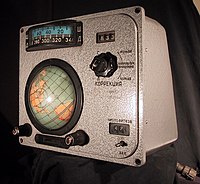
Globus IMP instruments were spacecraft navigation instruments used in Soviet and Russian crewed spacecraft. The IMP acronym stems from the Russian expression Indicator of position in flight, but the instrument is informally referred to as the Globus. It displays the nadir of the spacecraft on a rotating terrestrial globe. It functions as an onboard, autonomous indicator of the spacecraft's location relative to Earth coordinates.[1] An electro-mechanical device in the tradition of complex post-World War II clocks such as master clocks, the Globus IMP instrument incorporates hundreds of mechanical components common to horology. This instrument is a mechanical computer for navigation akin to the Norden bombsight. It mechanically computes complex functions and displays its output through mechanical displacements of the globe and other indicator components. It also modulates electric signals from other instruments.
The IMP, in successively developing versions, has been used in Soviet and Russian crewed space missions ever since the world's first crewed spaceflight (Yuri Gagarin, 12 April 1961) through every crewed Vostok, Voskhod and Soyuz mission until 2002.
- This article specifically covers IMP Version 3, used in Voskhod 1, since Version 3 has been more extensively documented than earlier versions used during the Vostok missions and subsequent versions for the more complex Soyuz. However all versions of the IMP were relatively similar with respect to design, purpose and operation.
- ^ Siddiqi, Asif (2003). Sputnik and the Soviet Space Challenge. US: University Press of Florida. p. 196. ISBN 978-0-8130-2627-5.
© MMXXIII Rich X Search. We shall prevail. All rights reserved. Rich X Search
